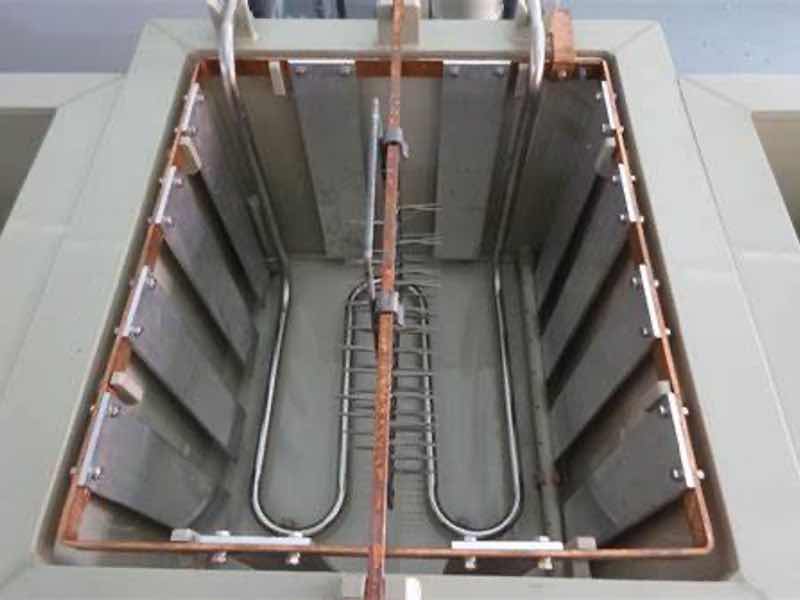Electrocleaning is a specialty surface treatment process that will be found in almost all plating operations, established in the surface preparation cycle.
 Stephen Rudy, CEFThis first portion of the process cycle is so critical to achieving the specified ultimate metal treatment and finishing applications or specifications.
Stephen Rudy, CEFThis first portion of the process cycle is so critical to achieving the specified ultimate metal treatment and finishing applications or specifications.
Why so prevalent? Simply, it has proven its importance to surface preparation, time and again. The process tank can be found in rack, barrel, and continuous strip lines.
Electrocleaning combines electrical and chemical action to remove organic and inorganic soils prevalent after the preceding soak cleaning step. These soils include metallic oxides, smuts, and scales. A versatile electrocleaner is also fortified with detergency to remove residual oil and grease. The first half of effective surface preparation includes soak and electrocleaning, to remove surface contaminants. This is critical to prepare the basic metal for activation. Let’s clarify some basic operating dynamics of electrocleaning.
The Nuts and Bolts
The picture provides a view of the electrocleaning tank. Steel or stainless steel cathode bars are fastened to each wall of the tank. Parts are placed on the middle anode rail. A stainless steel heating coil seen along the tank bottom is the heat source for steam. This is a heating example, as electric immersion heaters may also be used.
A DC rectifier is connected to the anode and cathode bars on the electrocleaner tank. Parts are predominantly anodically (positive) charged during treatment. Optionally, the electrocleaner tank walls may be cathodically charged, eliminating need for the steel or stainless steel sheets.
By turning on the rectifier, a powerful electrochemical redox reaction occurs. Water, the carrier solution, is electrolyzed, breaking down into its separate oxygen and hydrogen components. Oxygen is generated at the anode (parts) in an oxidation reaction. Hydrogen is generated at the cathode (bars or tank) in a reduction reaction. Oxygen formed on the parts dynamically scrubs the surface as it is formed and liberated. This action combines with the chemical components in the electrocleaner to clean and condition the parts.
Hydrogen forms at the cathode and is liberated. Since water is composed of a 2:1 ratio of hydrogen to oxygen molecules, twice the scrubbing action occurs at the cathode versus anode (parts). One assumes that more scrubbing is better. Why aren’t parts cathodically charged during treatment? Because trace metal contaminants and smuts — positively charged — steadily build up in the electrocleaner bath during its service life. Since opposite charges attract, these positively charged contaminants would deposit as barrier or contaminant films on negatively charged parts.
Activation in an acid treatment does not sufficiently remove these “plated-on” contaminants, detrimentally affecting subsequent steps in the plating cycle. That is why anodic treatment is so effective., In this way contaminants are “de-plated” off the metal surface, causing them to move away, depositing on the cathode. Over time, or when an electrocleaner is dumped, inspect the cathodes and observe the number of metallic smuts that have been plated on. These are the charged soils that have been removed from the parts. Another problem associated with cathodically charging parts in the electrocleaner would be the potential problem of hydrogen embrittlement.
Anodic electrocleaning of parts is predominant but not all-inclusive. Cathodic electrocleaning is preferred for sensitive parts, such as highly buffed finishes on brass, copper, and white metals, as examples. This treatment prevents oxidation which can result in excessive tarnish, etching, and pitting. Cathodic electrocleaning in a dedicated process tank is useful to activate passive nickel prior to chrome plating. It is also helpful to activate electroless nickel deposits in order to make them more susceptible to immersion stripping
Process Operation
As a first treatment, soak cleaning is expected to remove the bulk of oils and grease. The electrocleaner follows, where metallic films and oxides are removed. This should be the main function of a stand-alone electrocleaner. The concentrated formulation can be either liquid or powder. Sodium hydroxide (caustic soda) or potassium hydroxide (caustic potash) are the main constituents, providing sufficient solution conductivity. Special additives are included, which are also very important. These include buffers, inhibitors, wetting agents, descaling & derusting components, and hard water softening agents. The wetting agents lower solution surface tension. This permits the working solution to penetrate surface soils effectively, thereby removing them. This provides secondary capability to remove residual oils and grease while generating a thin surface foam blanket, suppressing corrosive mists. Additives for remove rust and scale may also soften these surface contaminants, facilitating removal in the next process tank, which is the acid. There are many proprietary electrocleaner concentrate formulations. The various types have been formulated to address specific surface treatments in a stable, long bath service life. In many instances, formulations also address specific process limitations or other conditions that would normally affect the electrocleaning process. Considerations include contaminant levels, processing of mixed metals, grades of steels, and tenacious metallic soils.
Based on process line layout or space constraints, a combination soak / electrocleaner is required. In this application, the soak and electrocleaner formulations are combined, permitting effective treatment in the same process tank. The advantages are simplifying product inventory, conservation of rinse water, and a double soak and electrocleaning in two separate tanks without an intermediate rinse.
Periodic reverse or PR electrocleaning is a specialized treatment for scale and rust removal from steel. The polarity on parts is automatically changed from anodic entry to cathodic to anodic exit. It takes advantage of the cathodic scrubbing, then switches to an exit anodic treatment deplating any charged contaminants deposited in the previous treatment.
The typical electrocleaning settings for rack, barrel processing with consideration for base metal are given in the following table.
Electrocleaner Operating Parameters
| Current Density (ASF) | Voltage | |||||
| Base Metal | Cleaning | Rack | Barrel | Rack | Barrel | Time (min) |
| Steel | Anodic | 50-100 | 10-20 | 4-8 | 8-12 | 1-5 |
| Stainless | Anodic | 50-100 | 10-20 | 4-8 | 8-12 | 1-5 |
| Brass | Anodic | 15-30 | 5-10 | 6-9 | 9-13 | 1-3 |
| Copper | Anodic | 20-50 | 5-15 | 6-9 | 9-13 | 1-4 |
| Zinc | Anodic | 10-20 | 5-10 | 6-9 | 9-13 | 1-4 |
| White metal | Cathodic | 10-20 | 5-10 | 2-4 | 5-7 | 1-2 |
Typical Electrocleaning Problems
Problems may include:
- Etching of steel with brown filming. The electrocleaner concentration may be low, Specifically the sodium hydroxide or potassium hydroxide formula component. Increasing the electrocleaner concentration, or a formulation modification to a higher caustic level is required. The etch appearance would resemble burning due to lack of conductivity, and the brown film is iron hydroxide not dissolved due to low reserve alkalinity.
- Corrosive pitting. This usually occurs if an acid pickle containing hydrochloric acid is dragged in, such as the second electrocleaner in a double cleaning cycle. Chloride is oxidized to chlorine gas on the parts forming the black corrosive pits. Change to a non-chloride-containing acid or use an electrocleaner with a specialized inhibitor to address the problem.
- In some process lines, that incorporate chromium in either a chromeplating step or chromate, the occurrence of chromium contamination is real and detrimental. The anodic electrocleaner strips the chrome or chromate deposit.
- The basis metal surface is passivated by the chromium contaminant. This results in passivation that results in subsequent electroplated deposits having poor adhesion, blistering or peeling.In addition, the hexavalent chromium tends to complex the electrocleaner bath surfactants and wetting agents, eliminating cleaning efficiency. In a most obvious observation, the hexavalent chromium contaminated cleaner turns yellow in color and the foaming action may be non existent. Add a hexavalent chromium reducing agent or switch to a formulated electrocleaner that contains this additive.Within about twenty minutes the reducing agent will react with the hexavalent chromium reducing it to the trivalent state, which then precipitates as sludge. In addition, the solution color reverts to a brown / green and foaming action returns.
- Dezincification of brass. Electrocleaner buffering is out of balance, or one is using the wrong electrocleaner (such as meant for steel) formulation for the in-tank requirement.
- White pits and corrosion of zinc. The electrocleaner concentration is out of balance, or one is using the wrong formulation (too high alkalinity). Use a formulation with correct caustic to inhibitor balance.
- Unable to achieve targeted voltage or current density, where electrocleaner chemistry is optimum. The problem may be an electrical issue with the rectifier or loose contacts from rectifier to tank. It also happens that in a cleanout or maintenance procedure, the anode and cathode contacts from rectifier to tank have been crossed.
Stephen F. Rudy, CEF, is president of Chem Analytic and has written extensively about the finishing industry. Visit www.chemanalytic.com or call him at 917-604-5001.



































